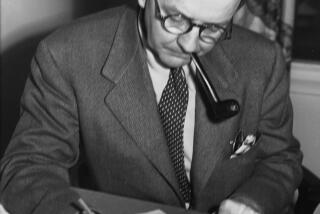Secrets unshared
The “several lives” of Joseph Conrad have been much discussed. As John Stape declares in his preface, his biography is of the “fourth generation . . . (post Aubry and Curle, Baines, Karl and Najder),” and few new facts emerge. The first two in this list of biographers were Conrad’s friends, and their work is hagiography. Jocelyn Baines began the task of critical assessment in the 1950s, and Frederick Karl and Zdzislaw Najder provided sustained analysis of a very secretive man. Indeed, Karl’s thousand-page “Joseph Conrad: The Three Lives” (1979) would seem to render the present effort supernumerary, but Stape has had access to letters “opened” since the 1980s, as well as the advantage of perspective. Here, his principal concern is to place the author in context -- to correct misunderstandings and debunk old myths.
Jozef Teodor Konrad Korzeniowski (1857-1924) was neither a Polish nobleman nor the nephew of a French princess; he was extravagant but not excessively so, prickly but not without cause. His sexual escapades were few and unrecorded, his family life not more troubled than most, and though he had bouts of depression and gout he died at home, at peace, at the age of 67 in the England he’d learned to call home.
This book has a large apparatus. There are photos and maps, a note about place names, a note about the value of money as indexed to inflation; there are family trees and biographical summaries, such as “Conrad’s Circle: A Select Who’s Who.” We are further offered a guide to pronunciation, since the writer’s world was polyglot -- although whether we need to know how to pronounce the names of such characters as Antonia Avellanos and Martin Decoud (from “Nostromo”) is another matter, since their names are never mentioned in the body of this book. Throughout Stape’s account, information abounds. Here’s a characteristic listing of more than we need to know about the people in his life:
“With John at school, and Jessie’s condition worsening, the three Conrads again left for a fortnight in London for medical treatment. Conrad with Miss Hallowes checked into the Norfolk, close to Pinker’s office, where Conrad planned to dictate more of ‘The Rescue.’ The hotel afforded good underground connections to Jessie’s Baker Street nursing home, where she was to be operated on, pending Sir Robert Jones’s return from the Italian front.”
Or, of a trip to Sicily:
“Always keen for excursions and company, Jessie enjoyed their trips round the island as far as Bastia. Through Sir Maurice Cameron, an old friend of Hugh Clifford’s, the Conrads became acquainted with a young Irish artist, Alice S. Kinkead, who later painted oil portraits of them. Conrad also met the French playwright, Henri-Rene Lenormand, who offered to lend him Freud to read. . . . Conrad politely declined.”
Far from a critical biography, “The Several Lives of Joseph Conrad” wants to place its man in terms of society, seafaring, politics, exile, the history of publication and stage adaptations and bad debts and quarrels and dinners and bank accounts; the only absence here is an analysis of texts. Importance is assumed. We know more about the writer’s failure to meet deadlines than the books with which he failed. Indeed, one can’t shake the sense that Stape offers everything about his subject’s life but the reason we might want to study it; he so scrupulously avoids assessment of the scope and thrust of Conrad’s art that we are left to take on faith his pronouncements as to chaff and grain. Some books, he declares, are masterworks, others hurried failures, but these judgments too are hurried and abrupt.
This is doubly a shame since much that’s well expressed is within the book. The diction may at times seem over-Englished; characters dress in “full fig” or have their hopes “put paid.” But Stape writes with clarity and wit; of Conrad’s mother’s love for her husband, he observes: “Surviving photographs of Korzeniowski suggest that the beauty she discerned was of the inner kind.” And when he does deliver a critical opinion, it’s both well wrought and provocative:
“Although incontestably a great writer, having contributed to shaping the way his own and the generations after him ‘see,’ he is, perhaps, in the scheme of things, not quite a ‘great’ novelist, missing -- just -- the glacial perfection of a Stendhal or Flaubert, and in this perhaps more closely resembling the achievement of a Tolstoy or Dostoevski. His style, in the main so sinuously seductive in cadences new to the language and crafted from a polylinguistic heritage, can fall into mere brittle mannerism . . . or at times flap about as his grasp on grammatical niceties and idiom relaxes.”
The magisterial study of Conrad by Ian Watt (unaccountably absent from Stape’s long list of sources) perhaps said all we need to know about the artistic endeavor. But this reader would have welcomed some sustained attention to the points addressed above, rather than simple assertion. We are informed, by its author, “The present book is thus deliberately constrained, addressing not the work and the life, but, rather, as its title suggests, the lives, in the hope of offering a portrait of a man who was unremittingly private.” And it’s no doubt unfair to expect of a biography what the biographer excludes. Yet the portrait that emerges here is of an old seafaring and improvident crank, not “incontestably a great writer.” Conrad’s privacy remains intact, and his best work -- for what is art if not a privacy made public? -- endures.
More to Read
Sign up for our Book Club newsletter
Get the latest news, events and more from the Los Angeles Times Book Club, and help us get L.A. reading and talking.
You may occasionally receive promotional content from the Los Angeles Times.







